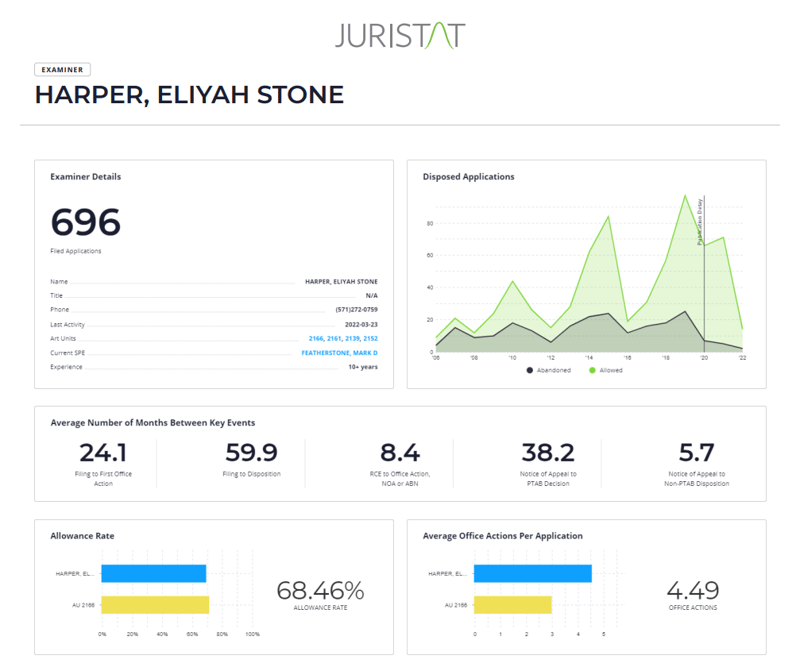To craft an unbeatable prosecution strategy, patent attorneys should rely on the multi-dimensional analysis of an examiner’s data, rather than just summary metrics.
We can call agree that each examiner at the USPTO is unique in how they approach the applications that come across their desk. The overall success of your prosecution strategy is completely dependent on the individual experience and outlook of thousands of examiners.
The USPTO makes its database publicly available, but it’s massive, messy, and almost impossible to navigate efficiently, let alone, rely on to make actionable decisions. You may be thinking: Wouldn’t it be easier if someone analyzed all the data and distilled each examiner down to a single, color-coded rating?
Well, yes. It would be easier. But it would be like assembling a bicycle without the wheels – it may take less time, but it’s missing a critical component.
Prosecution strategy is complex by design, and for a patent attorney to successfully move a patent from idea to allowance, you need to explore the full picture of an examiner’s history at the USPTO — not just a singular data point.
Examiner behavior cannot be boiled down to one simple metric because there are three, often opposing, metrics that interest attorneys and their clients: (1) examiner difficulty, (2) application cost, and (3) average timeline.
- Examiner Difficulty: How likely is it for this examiner to grant an allowance, regardless of how many office actions the application goes through or how much the claims are narrowed?
- Application Cost: We hear it all the time – firms are increasingly locked into flat fee agreements that pay a set amount for a certain number of office actions. Additionally, many assignees are capping fees after the threshold is reached. Knowing you are in front of an examiner who typically requires more office actions than what is budgeted can help you convince clients to make an exception before prosecution begins or at least manage their expectations when the inevitable rejection occurs that takes you above your original budget. Weighing costs separate from difficulty can keep your firm profitable and clients happy.
- Average Timeline: Yes, time is heavily tied to costs – the more office actions issued, the more prosecution costs, and the longer it takes. But some examiners are speedier than expected when getting through their docket, while others are slower. Additionally, examiners who demand more appeals will have a higher average time to allowance without necessarily increasing the number of office actions issued. With all this in mind, time to allowance can be incredibly meaningful for startups looking for funding, biotech companies keeping an eye on regulatory approvals, and other entities operating on a deadline related to intellectual property.
Let’s look at some specific scenarios:
Imagine an examiner ultimately allows more than half of the cases they see but requires practitioners to go through far more rounds of prosecution than average. One such examiner is Eliyah Stone Harper. In their 10+ year tenure at the USPTO, Harper has a 68.46% allowance rate but averages 4.49 office actions per application. Knowing this, what color grade or score would you expect Harper to have? A middling “yellow” score because you’re slightly less likely to get an allowance? An alarming “red” because they’re probably going to take you over budget? And how will you know which factor affected the rating?

Or, in another scenario, how would you compare two examiners – both with low allowance rates – but with wildly different records in PTAB proceedings. For example, Examiner Mohammad Nilforoush has only a 22% allowance rate but becomes easier on appeal, where applicants overcome rejections in PTAB proceedings 60% of the time. Compare this to the more precarious scenario of an examiner with a low allowance rate which is almost always upheld by the PTAB. Examiner Victor S. Chang has only a 30% allowance rate and is upheld by the PTAB 63% of the time. Both Shurr and Chang would probably be scored a difficult “red” rating, but one might be far easier than the other if you had multi-dimensional, transparent data at your disposal.
While just categorizing an examiner on a basic color scale of green, yellow, and red takes mere seconds, it will often leave you with an oversimplified impression and cause you to miss opportunities to deliver success to your client. It takes only a few more minutes to analyze the examiner more deeply and develop a prosecution strategy that is truly tailored to your client's needs.
CLICK HERE TO WATCH THE ON-DEMAND WEBINAR:
Advanced Examiner Analytics for Smarter Patent Prosecution
This is why Juristat Analytics gives our clients access to the full picture — transparent, dynamic reports that show everything from an examiner’s allowance rate, to average times between key events, to average office actions per application — all actionable metrics for setting client expectations. It also contains a multitude of other helpful items, like OCR’d office actions and appeals from past applications the examiner has allowed or rejected.
This multi-dimensional view of the examiner’s history at the USPTO takes all of the complicated data around an examiner and distills it into an easy-to-analyze series of charts and tables, without any complex, proprietary grading scales. From here, a patent attorney can have a complete understanding of their examiner and craft the perfect strategy to get to an allowance in the least amount of time, with the fewest office actions, and with the tools and resources to overcome any rejection.
When you’re looking to improve your patent prosecution and increase your allowance rate, Juristat’s Examiner Reports are an essential tool in your arsenal.
Want to see our Examiner Reports in action? Watch our on-demand webinar, ”Advanced Examiner Analytics for Smarter Patent Prosecution,” or schedule a personalized walkthrough.
(gradient).webp)

